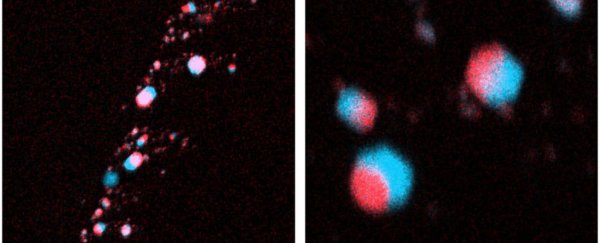Scientists have discovered that tiny diamonds found inside a meteorite show signs of originating in a lost planet - one that dates back to the earliest days of the Solar System.
This amazing finding could help us figure out one of the most enduring questions of astronomy, that of the formation of planets.
According to researchers from the École Polytechnique Fedérale de Lausanne, the diamonds from an asteroid called Almahata Sitta, which fell into the Nubian desert in October 2008, formed at pressures consistent with early Solar System protoplanets.
There are many mysteries about the formation of planets, but based on our own Solar System and studying the growing number of exoplanets, we more or less know how it might work.
It all starts with dust grains in the protoplanetary disc around a young star. Thanks to electrostatic forces, these grains start to cling to each other.
If enough grains of dust gradually accumulate to form larger clumps, and then enough of those clumps collide and fuse together, the whole thing gravitationally collapses into a more solid body between 1 and 10 kilometres in size - a planetesimal.
Most planetesimals stay that size. But some, with the aid of their magnetic field and eccentric orbits, collide and join together, often at high speed, building up into larger objects between the size of the Moon and the size of Mars, with a molten core.
These are called protoplanets, the "embryos" of planets, and the early Solar System had hundreds of them.
 An artist's concept of a protoplanetary disc. (NASA/JPL-Caltech)
An artist's concept of a protoplanetary disc. (NASA/JPL-Caltech)
Over time, they repeatedly collided with each other, fusing into bigger and bigger masses until they formed the planets we know today.
And the asteroids still floating around the Solar System, astronomers believe, are the leftovers from those days - from the repeated collisions that blasted material back into space.
Almahata Sitta was a rare case - the first time meteorite material had been retrieved from an asteroid that had been tracked from space and during its collision with Earth.
But that's not the only thing that made Almahata Sitta special. It turned out to be a rare type of meteorite called ureilite, which has an unusual composition compared to other stony meteorites - it contains a lot of carbon in the form of nanodiamonds.
There are three formation models for ureilite: shock-driven transformation of carbon to diamond via high-speed impact; chemical vapour deposition inside the solar nebula; and static high-pressure inside a larger body, such as a protoplanet.
However, until now, no evidence could be found to confirm any of these methods over the other.
The researchers, led by planetary scientists Farhang Nabiei, studied the diamond inclusions inside the meteorite and found relatively large, individual diamond crystals up to 100 μm that could not have formed under an impact event, because of such an event's short duration, which would not allow time for such large crystals to form.
Nor, the researchers said, could chemical vapour deposition have produced the crystal sizes - which leaves static high pressure.
The other fascinating thing about diamonds is that, as they are forming, they often trap minerals present in their formation environment. Using transmission electron microscopy and electron energy-loss spectroscopy, the team analysed the Almahata Sitta diamonds to see what these mineral inclusions were.
They discovered chromite, phosphate and iron-nickel sulfide embedded in the diamond, with compositions and morphologies that could only have occurred under greater pressure than 20 gigapascals - nearly 200,000 times that of sea level atmospheric pressure.
Here on Earth, most diamonds are formed at around just 4.5 gigapascals. The team's result suggests that the diamonds in Almahata Sitta formed in a Mercury- to Mars-sized protoplanet.
"Although this is the first compelling evidence for such a large body that has since disappeared, their existence in the early Solar System has been predicted by planetary formation models," the researchers wrote in their paper.
"Mars-sized bodies were common, and either accreted to form larger planets, or collided with the Sun or were ejected from the solar system.
"This study provides convincing evidence that the ureilite parent body was one such large 'lost' planet before it was destroyed by collisions."
The research has been published in the journal Nature Communications.
